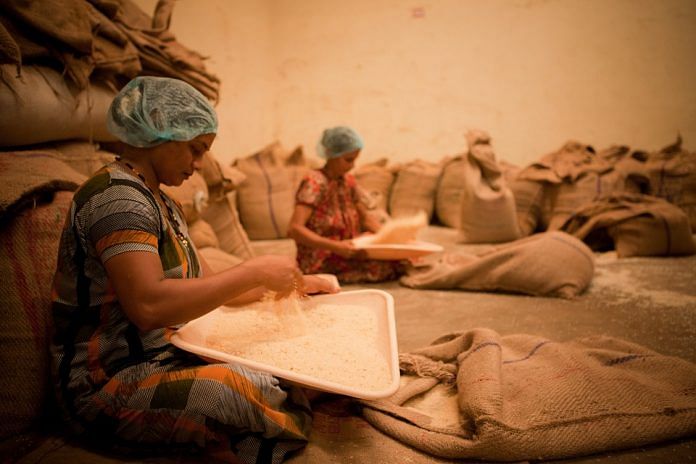The World Economic Forum report says India dropped 21 places since 2016, and 10 positions since 2006, in the Global Gender Gap Index. In terms of economic participation and opportunities for women, India dropped from 110th to 139th; in educational attainment, it dropped from 102nd to 112th; and in health and survival, it dropped from 103rd to 141st. The only improvement was in the area of political empowerment, where India rose from 20th to 15th.
Read our full report on Global Gender Gap Index here
Invisible, unemployed, and under-educated, is the Indian economic progress of the past decade failing its women?
India is drawing more girls into schools, but is weighed down by patriarchy
 Anubhuti Vishnoi
Anubhuti Vishnoi
Deputy Editor, ThePrint
The WEF’s report on gender gap says that it may take another century to close the global gender gap and over two centuries to address the most challenging gap areas — economic participation and health. The key to both is education attainment.
India slipped down several places from 2006 to 2017 on education attainment. This came in the decade that focussed on government initiatives to bring more girls into schools, and improved female enrolment levels from primary to higher education.
India ranks on the top of the list with 92.9 per cent female enrolment in primary sections and 62.2 per cent female enrolment at secondary level vis-a-vis 91.7 and 61.4 respectively for male children.
India is drawing more girls into schools, but is weighed down by patriarchy.
The 59.3 per cent female literacy rate vs 78.9 for males, and the 118th rank on the parameter point to the basic educational gap.
Central and state governments have focussed on introducing separate toilets for girls, and providing bicycles, in order to retain girls in secondary schools.
The burden of domestic chores on young girls at puberty affects their learning levels and overall school engagement.
The WEF data shows 73.9 per cent of Indian women are married by age 25 while only 34.7 per cent men are married at that age; 49.3 per cent young females are found not in employment or education against just 8 per cent males; 7.75 per cent adult women are unemployed while the figure is 4.1 per cent for men; females have a mere 1.8 per cent share of high skilled labour force while males bag 8.1 per cent.
Women opt out of professional education when they marry, and typically, drop out of work due to child care. It is a story of inequitable burden of domesticity on women.
A large segment of the female workforce is engaged in the unorganised sector — mostly agricultural. Unpaid work per day, as per the WEF data, is 65.55 per cent for women vis-a-vis 11.75 per cent for men. Women clock in over 530 minutes of work per day against 442 minutes by their male counterparts.
Only enhanced social support can help the girl remain in the classroom, and later, enter the boardroom.
Indian women – why are we surprised at a widening gender gap?
 Amir Ullah Khan
Amir Ullah Khan
Professor of Economics at the Maulana Azad National Urdu University, visiting faculty at ISB, teaches health economics at Manipal University
On the UNDP’s gender inequality index, India is second from the bottom. The International Labour Organisation has ranked India 121 out of 130 on female work participation rates. Twenty million Indian women quit work in the last 10 years.
Even as we see handsome improvement in the Ease of Doing Business and in rising stock market indices, the gender gap keeps growing.
A quick look at government expenditure gives a possible clue to understanding this paradox. In the first full Union Budget passed by the new government, the biggest cuts were for health, women, and nutrition. The reproductive and child health flexible pool was cut by 21 per cent. The Integrated Child Development Scheme was reduced by 51 per cent. Sarva Shiksha Abhiyan and the mid-day meal schemes were reduced by 20 per cent each. The biggest cut was seen in the Women and Child Development ministry, whose budget was reduced to Rs 10,382 crore from Rs 21,192 crore.
This, despite the fact that in the legion of marginalised communities, the most neglected are women. Sex ratios are horrifying. The girl child goes to school, but drops out in large numbers within six years. An average Indian mother weighs less at the end of her pregnancy that the Sub-Saharan African. The Indian child is shorter and smaller than counterparts anywhere.
While the Millennium Development Goals target was 103, India still sees 178 out of one lakh mothers dying during child birth. A Princeton study shows that 42 per cent of Indian mothers are underweight compared to 16.5 per cent in the poorest parts of the world. As Amartya Sen argues, women have restricted access to healthcare largely because they have limited control over their lives. The gender gap will reduce when women have full control over reproductive rights, study all they want to, and access high quality maternal and child care.
WEF report demonstrates reduced social opportunities for women and the lack of a gender-directed social policy.
 Manisha Priyam
Manisha Priyam
Associate Professor, National University for Educational Planning and Administration
The report of the World Economic Forum highlighting increasing gender gaps on a global comparison and ranking in several areas is indeed bad news. The decline in educational attainment for girls tells us that much of the achievements that had been made in educationally underdeveloped BIMARU Indian states on the basis of reversing gender gaps after the 1990s has received a dent.
So, while there may be more number of girls being brought to schools, a reported increase in participation or enrolment, they are not learning much. This is confirmed by ASER reports which talk of lack of reading and mathematical abilities of Grade 5 students, barely equivalent to the required levels for Grade 1 beginners.
The import of this becomes severe when combined with the decline in health outcomes as seen in the lower rank from 147 to 103. Together, this reads as reduced social opportunities for women.
It must be noted that emerging economies such as Brazil have improved social opportunities for women, specially health and education, through their focussed social protection programmes such as the Bolsa Familia in the last decade. While Brazil is a late entrant to democracy, having ended authoritarian rule only in the 1980s, it has displayed a far greater commitment to reducing gender inequality through state-directed social policy. Attendance in functioning schools and in health and maternal care centres are a composite element of the Bolsa Familia. Brazil ranks number 1 on educational attainment parameter, and it gained eight points in the economic participation and opportunity rankings since 2016. Health and survival remained at No.1.
With a quarter century of policy reforms in India (beginning in 1991) and developmental policy and politics in Indian states, these WEF report results, however, demonstrate the lack of a gender-directed social policy. They go against the grain of equitable growth. Inequality directed against women, and invisibility of women in the public sphere work places (which require women to compete as equals) is a likely prevalent scenario. Greater political empowerment and participation of women by itself may not reverse these.
Only 11 per cent of our MPs are women, and on the internet, women’s participation is 29 per cent
 Ranjana Kumari
Ranjana Kumari
Director, Centre for Social Research
Over the past decade, India’s economy has been growing at one of the fastest rates, nearly clocking 7 per cent per annum of our GDP. However, it is unfortunate that this rapid growth rate has not resulted in on-ground impact for women. Even after 70 years of independence, the socio-economic condition of women across different parts of the country remains poor.
While on one hand, there is an increased percentage of women’s literacy and women professionals, female infanticide, poor health, maternal mortality, child marriage, and lack of education still persist.
Only 11 per cent of our MPs are women, which is below global average. On the internet, women’s participation is 29 per cent.
The participation of women in the workforce fell 10 per cent in the past decade as India recorded the lowest female labour force participation rate. The proportion of working women who were paid for their work in cash fell four percentage points over the past decade to 24.6 per cent. Though there was an increase in the number of working women in India during 2000-2005, increasing from 34 per cent to 37 per cent, the female labour force participation rate has reduced continuously thereafter and reached 27 per cent in 2014. According to the National Family Health Survey, public health initiatives have had minimal impact on women’s health. However, violence from their partners has reduced and female participation in household decisions has increased. There is a slight drop in women’s land ownership but an increase in the number of bank accounts for women.
Women occupy less space in India’s growth story compared to men. We cannot let economic development be a male-centric phenomenon, and limit our progress socially and culturally. Moving forward, we must ensure that our policies and government programmes focus on impact that improves the socio-economic condition of women in India.
Gender equality is not only a pressing social and ethical concern, but also an economic imperative.
 Urmi Duggal
Urmi Duggal
Trainer on women’s leadership
World over, progressive leaders and thinkers are recognising that gender equality is not only a pressing social and ethical concern, but also an economic imperative. The ‘case’ for gender equality in India is even stronger.
Women comprise half of India’s population (48 per cent), have increased their share in higher education (46 per cent of graduates are women), and yet, the female labour force participation is an abysmal 27 per cent. For the women that do participate in the workforce, the rate of attrition within the talent pipeline is high. An approximate 50 per cent of women drop out of the workforce mid-career, before they turn 30. The barriers to gender equality and women’s leadership increase as they move up the ladder. Only 16 per cent of all the senior leadership roles are held by women in India.
These alarming realities have made corporates and business leaders cognisant of the extent of gender inequality and the detrimental impact it has on the economy. According to McKinsey Global Institute projections, India could add $700 billion to its gross domestic product by 2025 if it made faster progress toward gender equality. Armed with this knowledge, corporates have been working towards increasing female labour force participation and creating more gender equitable workplaces. There has been increasing dialogue regarding analysing company policies regarding maternity, sexual harassment, and promoting women’s leadership. A number of Indian companies have also signed on to the Women Empowerment Principles. The recent Maternity Act passed by the Parliament is also a step ahead in improving women’s position in the economy and protecting their rights.
However, going forth, we need to be careful about believing that making a ‘business case’ for gender equality is enough. The need of the hour is also to recognise that equal opportunities for employment and equal pay are matters of human rights, because disregarding this fact can lead to the commodification of women and a reduction in their ability to generate profit. Therefore, any programme or solution that works towards improving women’s position in the economy must be informed by a human-rights based approach.
The backbone of the formal economy rests on the invisibility of the woman, and it’s time to come out of the shadows.
 Nandita Singh
Nandita Singh
Journalist, ThePrint
The liberalisation of the Indian economy with the 1991 economic reforms led to an assimilation of our largely underdeveloped nation into the global market for which, perhaps, it was not culturally ready. The WEF Global Gender Gap Index sheds light on increasing inequality between men and women along the parameters of economic participation, access to education, political representation, and health and survival.
However, when attempting to understand the reasons behind the existence and ramifications of a glass ceiling, one must remember the hidden foundations on which it was built.
The entry of educated women into the economic workforce was only possible if their role-vacuum at home was filled either by them working double-time, or by someone else. India’s National Sample Survey (NSS) excludes those that “attended to domestic duties only” as a category of employment. Eighty per cent of India’s domestic help are females, and if their work, along with that of the housewife’s, was to be considered as contributing to output, the WEF ranking of 139/144 on economic participation might tell a different story.
As long as the domestic space remains the sole burden of a ‘wife’ or ‘mother’, girls will continue to drop out of school to get married, quit mid-career to raise a child, and fail to go up on a corporate ladder that is already biased against them. To begin with, two things need to happen simultaneously — work done in the domestic sphere needs to be included in the formal economy, regulated to prevent exploitation, and given equal status in terms of respect and professional credibility. And men need to start contributing significantly to maintaining the very house that allows them to work in the first place. The backbone of the formal economy rests on the invisibility of the woman, and it’s time to come out of the shadows.






